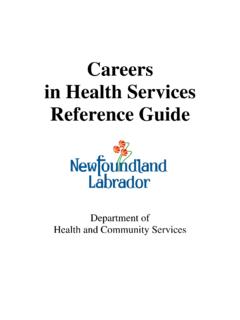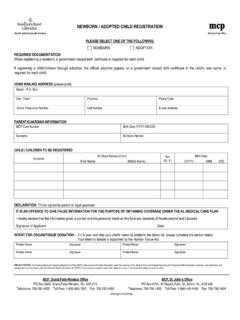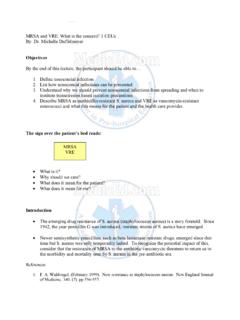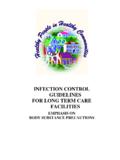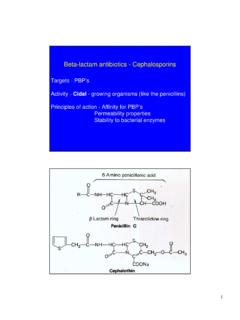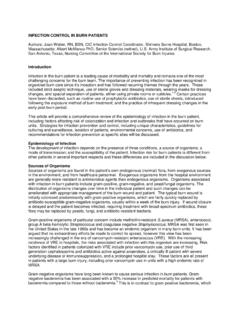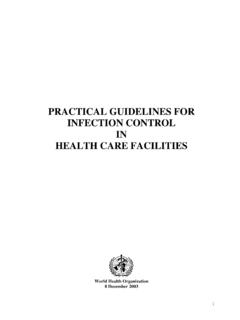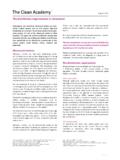Transcription of MRSA Manual for Nurses - health.gov.nl.ca
1 MRSA: A Resource Manual for Nurses and other Healthcare Workers in Acute Care Settings Developed by: Amanda Whelan, Whelan, MN, BN, BN, RN. & Donna Moralejo, Moralejo, PhD, RN. Memorial University School of Nursing Endorsed by: Provincial Infection Control Newfoundland Newfoundland Labrador (PIC- (PIC-NL). November 2011. Who is this resource Manual for and Why? Are you a new nurse and not sure how to put a patient on Contact Precautions? Or perhaps you're an experienced nurse dealing with MRSA for the first time in a long time. Maybe you just want to know what the difference between colonization and infection with MRSA is. This Manual has been developed for Nurses but may be useful for all healthcare workers.)
2 Many of us figure we know enough about MRSA, but do you really? There are a lot of myths and misinformation surrounding MRSA. Test yourself! Are the following statements true or false? Turn to page 4 for the answers, and refer to the different sections in this resource Manual (listed on page 5) to learn more about MRSA. and caring for patients with MRSA. MYTHS AND MISINFORMATION. Are the following statements true or false? 1. All Nurses are MRSA positive. 2. I don't need to wear gloves when checking the blood pressure of a patient with MRSA. 3. Nurses always clean their hands properly. 4. It's only MRSA, the doctor will order some antibiotics and it will be gone. 5.
3 It takes too much time and effort to put on gloves and a gown. IF YOU THOUGHT THE STATEMENTS WERE TRUE, THEN THIS Manual IS FOR YOU! IS ANOTHER RESOURCE Manual ON. INFECTION PREVENTION AND CONTROL NECESSARY? Methicillin-resistant Staphylococcus aureus (MRSA) is an ongoing problem for institutions world-wide. There are many places where you may find the information you are looking for, , institutional Infection Prevention & Control policies and procedures or the internet, however, at times these are neither easily accessible nor user-friendly. This resource Manual will provide a quick and easy reference for the information you need. 2. How can you use this resource Manual ?
4 This resource Manual is divided into sections which will provide answers to questions or concerns that may arise when dealing with MRSA. Use it as an educational tool Use it as a reference to refresh your memory or skills Use it to gain the knowledge and skills necessary to prevent and control the transmission of MRSA in your setting. This MRSA Resource Manual is for use in any healthcare setting. It can be used in acute care settings, long-term care settings, and in community settings. The content of this Manual is intended to provide information and guidelines. You must follow the policies and procedures of the institution where you work! This resource Manual is based on infection prevention and control guidelines as set out in the Newfoundland and Labrador Guideline for Routine Practices and Additional Precautions (Department of Health & Community Services, 20091), Newfoundland and Labrador Guidelines for Management of Multidrug-resistant organisms across the Continuum of Care (Department of Health & Community Services, 20072) and Best Practices for Infection Prevention and Control of Resistant Staphylococcus aureus and Enterococci (Ministry of Health and Long-Term Care/Public Health Division/Provincial Infectious Diseases Advisory Committee, 20073).
5 Every effort has been made to reflect the most up-to- date evidence available at the time of writing. 3. Myths and Misinformation: the Real Facts # 1: All Nurses are MRSA positive. In fact, this could not be further from the truth. Several studies have estimated that approximately 5% of healthcare workers (HCWs) are colonized by , 5. # 2: I don't need to wear gloves when checking the blood pressure of a patient with MRSA. Since MRSA has been found on the patient's skin and can survive in the environment on surfaces such as over bed tables, counter tops, and door knobs, gloves must be , 6, 7. Gloves prevent the contamination of the hands. # 3: Nurses always wash their hands properly.
6 Many research studies have been completed observing rates of hand hygiene compliance for HCWs. The results vary from 11% to 58%.8, 9 Therefore, there is room for improvement for all professions in all healthcare settings. # 4: It's only MRSA, the doctor will order some antibiotics and it will be gone. Patients developing MRSA infections can be treated with vancomycin. However, new strains of MRSA are emerging that are resistant to this antibiotic, further reducing treatment # 5: It takes too much time and effort to put on gloves and a gown. The time it takes to put on a gown and gloves is approximately one minute. In one study it was found that the same HCWs citing lack of time as a reason for not wearing gloves and a gown were noted to not follow proper procedures regardless of time 4.
7 What Information Are You Looking For? What is Staphylococcus aureus? .. 6. What is MRSA?.. 6. What is CA-MRSA? .. 6. What is the Difference between Colonization and Infection? .. 7. 7. Infection .. 7. Is MRSA Really a Problem?.. 7. What Can You Do to Decrease the Transmission of MRSA? .. 9. How is MRSA Transmitted? .. 10. Direct contact transmission .. 10. Indirect contact 10. Can you Recall the chain of infection?.. 10. How Can You Prevent the Transmission of MRSA?.. 12. Routine 12. Hand 13. When Should You Perform Hand Hygiene? .. 13. How do you perform hand hygiene?.. 15. Personal Protective Equipment (PPE).. 17. Errors committed when using PPE .. 17. Gloves .. 18.
8 Gowns .. 19. Contact Precautions .. 21. 1. Hand Hygiene .. 22. 2. Personal Protective Equipment .. 22. 3. 22. 4. Healthcare 25. 5. 26. 6. Patient 26. 7. Education .. 27. 8. Linen .. 28. 9. 28. Screening for MRSA .. 28. RISK Factors for MRSA 29. Collecting a Specimen for 29. Wrap-up .. 30. Test your Knowledge .. 32. References .. 33. 5. What is Staphylococcus aureus? To understand methicillin-resistant Staphylococcus aureus (MRSA), first you need to understand something about Staphylococcus aureus (S. aureus). It is a gram-positive bacterium periodically found on the skin and mucous membranes of most adults and is no cause for alarm. However, S. aureus can cause infections, which can be treated by various antibiotics such as cephalosporins, erythromycin, and tetracycline.
9 What is MRSA? When S. aureus develops reduced susceptibility to the beta-lactam class of antibiotics it becomes known as MRSA. Beta-lactam antibiotics include the penicillins (such as methicillin, dicloacillin, nafcillin, and oxacillin,). MRSA is also resistant to agents such as clindamycin, erythromycin, tetracycline, cephalosporins, and at times sulfamethoxazole-trimethoprim (Septra ). Infections with MRSA are treated with sulfamethoxazole-trimethoprim (Septra ) if susceptible, or with intravenous vancomycin. One big concern about the spread of both MRSA and vancomycin-resistant enterococci (VRE) is the possibility that the gene that codes for vancomycin resistance could be transferred from VRE to MRSA, which would enable MRSA to become resistant to vancomycin as well5.
10 What is CA- CA-MRSA? MRSA has also become prevalent in the community, known as community-acquired MRSA (CA-MRSA). These infections are not attributable to hospital stays or medical procedures within the previous year and can occur in otherwise healthy individuals. CA- MRSA infections appear as skin and soft tissue infections and are transmitted through close contact such as occurs with athletes, prisoners, and in daycare ,13 Although hospital-acquired (HA)-MRSA and CA-MRSA have genetic and phenotypical differences, both are transmitted in the same fashion, through direct skin-to-skin contact or contact with shared items or surfaces that have come into contact with someone else's colonized or infected skin.



